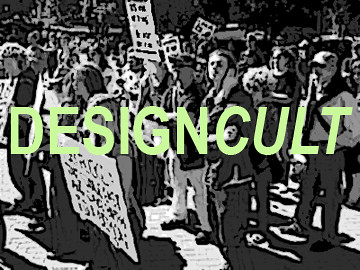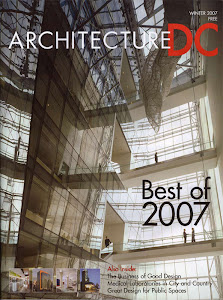 Modern residential architecture is appearing around just about every street corner in DC, except for maybe Georgetown. That is a whole other monster that will in due time get it's 15 minutes of critique. I applaud the architects of, and especially those who inhabit, modern buildings in Washington. In a city with rigid and often ridiculous hysterical (historic) preservation boards, it is prohibitively difficult to have an opportunity to allow modern design from today's society to make it's mark on the urban fabric. The area North of U Street and between 13th and 9th Streets NW, seems to be a melting pot of modernism. This neighborhood had mostly existed of run down Victorian tenement townhouses, empty lots and some relics of light industries that long ago closed shop. Within the last five years the empty lots have been built upon, the existing townhouses have been cleaned up, and the industrial buildings have been made into loft-esque spaces. For better or for worse, most of the new construction is in the modern vernacular. They have brought on mixed opinions, and have escaped the incriminating opinions of any historic board due to their location outside of the historic districts. They all have given modern residential architecture incorporated into an existing historic context more visibility, but at the same time have proved that not all modern architecture is good architecture. Three projects in this neighborhood were randomly selected.
Modern residential architecture is appearing around just about every street corner in DC, except for maybe Georgetown. That is a whole other monster that will in due time get it's 15 minutes of critique. I applaud the architects of, and especially those who inhabit, modern buildings in Washington. In a city with rigid and often ridiculous hysterical (historic) preservation boards, it is prohibitively difficult to have an opportunity to allow modern design from today's society to make it's mark on the urban fabric. The area North of U Street and between 13th and 9th Streets NW, seems to be a melting pot of modernism. This neighborhood had mostly existed of run down Victorian tenement townhouses, empty lots and some relics of light industries that long ago closed shop. Within the last five years the empty lots have been built upon, the existing townhouses have been cleaned up, and the industrial buildings have been made into loft-esque spaces. For better or for worse, most of the new construction is in the modern vernacular. They have brought on mixed opinions, and have escaped the incriminating opinions of any historic board due to their location outside of the historic districts. They all have given modern residential architecture incorporated into an existing historic context more visibility, but at the same time have proved that not all modern architecture is good architecture. Three projects in this neighborhood were randomly selected. 
The first is a corner lot infill project. Innovative materials as metal cladding, prefabricated masonry units, and storefront window systems are a great nod to the new residential materials available for construction today. Interlocking elements as balconies, louver sun screens and wrapping surface materials are where this townhouse gets an "A" for modern form and concept. Although, this building fails to make any sort of gesture to the existing context surrounding it. Instead of respecting the past by making a simple gesture to scale, materiality, or proportion, it stands out on its own merit, but in snubbed nose sort of way. A good round of editing in the design process would have eliminated random elements that give the overall design a "gimmick" like aesthetic.

The second is also an infill lot that borders on a public alley. This residential pocket in the city is by no means stylized by a consistent original vernacular. The older townhouses are all different and lack a large amount of detail. The dominating element that they all have is the proportion within the elevation divisions. The one third/two third typology exists with a bay typically occupying the two third section, and the front door on the one third section. This modern intervention holds to these proportions. It simplifies these elements using systems of glass and metal framework. Yet, it also neglects unifying fenestration head heights along with the material connections that are key to the execution of good modern architecture. Just because the ideas are simplified, does not mean you can neglect the details. The detailing in modern architecture can make the difference between sloppy and refined.

The last example is a multi-family building that is still under construction. Elements such as exposed structural steel framework and concrete slabs create interest in the elevation along with function as outdoor balcony space. Glazing systems and walls play the solid/void game instead of punched windows on a solid background. The strength of these elements will be determined by the material and color of the cladding yet to be applied. Again, editing in the design process can be the fine line between great and mediocre modernism.
 Modern residential architecture is appearing around just about every street corner in DC, except for maybe Georgetown. That is a whole other monster that will in due time get it's 15 minutes of critique. I applaud the architects of, and especially those who inhabit, modern buildings in Washington. In a city with rigid and often ridiculous hysterical (historic) preservation boards, it is prohibitively difficult to have an opportunity to allow modern design from today's society to make it's mark on the urban fabric. The area North of U Street and between 13th and 9th Streets NW, seems to be a melting pot of modernism. This neighborhood had mostly existed of run down Victorian tenement townhouses, empty lots and some relics of light industries that long ago closed shop. Within the last five years the empty lots have been built upon, the existing townhouses have been cleaned up, and the industrial buildings have been made into loft-esque spaces. For better or for worse, most of the new construction is in the modern vernacular. They have brought on mixed opinions, and have escaped the incriminating opinions of any historic board due to their location outside of the historic districts. They all have given modern residential architecture incorporated into an existing historic context more visibility, but at the same time have proved that not all modern architecture is good architecture. Three projects in this neighborhood were randomly selected.
Modern residential architecture is appearing around just about every street corner in DC, except for maybe Georgetown. That is a whole other monster that will in due time get it's 15 minutes of critique. I applaud the architects of, and especially those who inhabit, modern buildings in Washington. In a city with rigid and often ridiculous hysterical (historic) preservation boards, it is prohibitively difficult to have an opportunity to allow modern design from today's society to make it's mark on the urban fabric. The area North of U Street and between 13th and 9th Streets NW, seems to be a melting pot of modernism. This neighborhood had mostly existed of run down Victorian tenement townhouses, empty lots and some relics of light industries that long ago closed shop. Within the last five years the empty lots have been built upon, the existing townhouses have been cleaned up, and the industrial buildings have been made into loft-esque spaces. For better or for worse, most of the new construction is in the modern vernacular. They have brought on mixed opinions, and have escaped the incriminating opinions of any historic board due to their location outside of the historic districts. They all have given modern residential architecture incorporated into an existing historic context more visibility, but at the same time have proved that not all modern architecture is good architecture. Three projects in this neighborhood were randomly selected. 











No comments:
Post a Comment